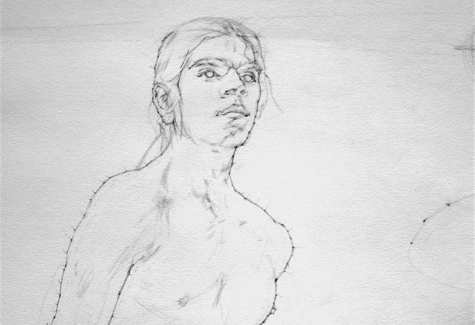Fine Art

Two Dimensional Shape
Shape is a primary aspect of visual experience. It’s in everything we see. As painters/draftsmen we benefit greatly from the ability to see and describe shape, and not only basic shapes, like circles and squares, but complex shapes and complex compositions of shapes. The human figure is just such a complex shape. Artists for centuries have practiced the art of figure drawing as a means of developing a more powerful and sensitive sense of shape. The block-in teaches us to see and construct this shape in an integrated way, employing points and line segments representing measurements of tilt and distance.
The Envelope
As a student I learned an approach to drawing that begins with an “envelope”. It’s like the egg out of which the complex shape of the block-in emerges. It carves out a space on the page; it’s the footprint of the future drawing. It doesn’t have to be perfect. (Besides, it never is.) It need not altogether encompass the whole figure; portions of the figure may lie outside. It is an irregular polygon composed of a few line segments. Its sides should be non-parallel, and of differing lengths. This is important. We need to look from side-to-side within the shape and make sure that it’s asymmetrical in every direction.
Evolution of the Block-In
A solar system congeals out of a vague dust cloud into an ordered arrangement of planets. Likewise a block-in begins with a tentative cloud of lines, rough statements of angles and lengths, sweeping point-to-point measurements, encompassing large stretches of drawing space. Gradually, it evolves from a broad approximation to a specific linear statement.
Relationship of the Block-in to the Movement
The block-in is an expression of the system of curves running through the pose. It is the shape of the movement. Its non-parallel, progressive, and tapering structure conducts the dynamic continuity of the gesture. The block-in is never blocky or static.
On the Use of Diagonal Lines
The block-in is not based on horizontal or vertical lines or measurements. Of the 360 degrees in a circle, only four: 0, 90, 180, and 270, represent vertical and horizontal lines. That leaves 356 other degrees representing tilts of different directions. Diagonal lines outnumber vertical and horizontal lines by a factor of 90 to 1. We use these to construct the living shape of the figure. This too is important. By working with angles we tap into the actual, unexpected shapes of the body. We do an end run around our conventional expectations and discover…what it really looks like. This is really helpful when it comes to foreshortening.
Convexity
The form of the body is full. Along with expressing the inner curve, we use the block-in to convey convexity. In the beginning, we rough out big masses of shape, like continents moving and crunching into one another, or stretching out in long, improbable promontories. These we refine, packing smaller, superficial forms on top of larger, deeper ones. Each individual form has a “trajectory”. It originates, arches outward, peaks, and then drops back over the horizon of the contour. These forms have origin-points, high-points and insertion points. Between these points we draw line segments with precise measurements of tilt and length.
Continuity
The succession of convex forms is continuous. From the major masses of the trunk, out through the arms and legs, and up the neck into the head, the shape modulates without interruption. Working with the block-in helps us to break down verbal, symbolic preconceptions. Fortunately for us, there are no borders and checkpoints separating the parts of the body from one another! The “hand” isn’t separate from the “arm” at the “wrist”. These aren’t three separate objects. The form of the arm modulates into the hand through the wrist. All is one, continuous, integrated structure. Through all the joints and transitions of the body, the block-in carries the movement, like sap in a tree.
How to Do It
You put in anywhere from three to six points as estimations of the most extended points on the figure, and you draw a shape, the envelope. You check this by scanning back and forth between the various points and line segments, checking the length and tilt by eye, or by holding up a pencil or stick, and by comparing the tilt/distance point-to-point relationships on the model to the ones in the drawing. Then you break the envelope down into big subdivisions, corresponding to big, abstracted shapes in the figure, always checking your point-to-point relationships. You keep on correcting and breaking down these big shapes until the block-in becomes so refined it disappears, and all that’s left over is the contour!
Visit www.theryderstudio.com for more information on art classes.